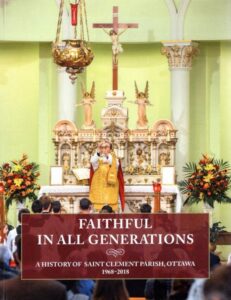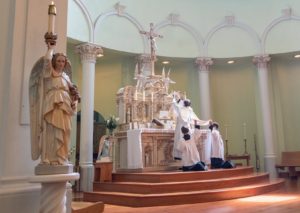
(Our parish history book is available in our bookstore)
St. Clement Parish at St. Anne Church offers Mass and the Sacraments in the traditional Latin form of the Roman Rite according to the liturgical norms of 1962. Mass is celebrated daily, preceded by the opportunity for confession. All the Sacraments of the Church are available by arrangement with a member of the parish clergy.
Making Faith History
St. Clement Parish and the church of St. Anne it now calls home, have marked the history of the Roman Catholic faith in Ottawa and beyond in a unique and remarkable fashion. The story of St. Clement Parish represents an impressive chapter in the history of the endurance and stability of the traditional Latin liturgy within the Roman rite of the Church. It is the oldest Traditional Mass Community in Canada and the first parish in the world to be established after Vatican II to meet the needs of the faithful attached to the Traditional Roman Rite, otherwise known as the “Tridentine” Mass or “Extraordinary Form”.

Humble Beginnings
The origins of the St. Clement community date from March 1968 when His Grace Archbishop Joseph-Aurèle Plourde granted permission to a small group of the faithful to gather in the Monastery of the Sisters Adorers of the Precious Blood on Echo Drive, for Sunday Mass in the Tridentine form. Canon René Martin, the Sisters Adorers’ chaplain, became the group’s first chaplain, followed shortly after by Fr. Guy Martin. In 1984, the Latin Congregation, now led by Fr. Georges-Henri Bélanger, acquired its first chapel located on Albion Road (then in Gloucester Township) which was placed under the patronage of St. Clement, pope and martyr. Nine years later, Msgr. Plourde’s successor, His Grace Archbishop Marcel Gervais made a proper church home available to the community located at 87 Mann Avenue, Sandy Hill, complete with rectory and basement hall and shortly after, elevated St. Clement to the status of a quasi-parish.
Such indications of stability were accompanied by significant growth in the parish population, prompting the archbishop to invite the newly formed Priestly Fraternity of Saint Peter to assume pastoral responsibility for the parish on 1 January 1995. Two years later in November 1997 Msgr. Gervais erected the quasi-parish into a fully integrated one in accordance with canon 518 of the Code of Canon Law. Made a personal parish by virtue of these canonical statutes, St. Clement thus became the first Catholic parish worldwide to be established after Vatican Council II to meet the needs of those remaining attached to the older liturgical traditions of the Roman rite.
The gift of St. Anne
In 2011, when Paroisse Sainte-Anne was forced to close its doors Msgr. Gervais’ successor, His Grace Archbishop Terrence Prendergast s.j. invited St. Clement Parish to assume responsibility for this historically significant church. After a year of study and prayer, it was decided to accept the archbishop’s invitation and transfer St. Clement Parish to the 140 year old church on Old St. Patrick Street in Ottawa’s Lower Town.
It is fitting that St. Clement Parish should have been invited to relocate to its new home at St. Anne Church for like St. Clement, St. Anne Parish marked the history of Roman Catholic faith both in Ottawa and beyond, making a strong contribution in the field of French language education, for example, that remains in place in Ontario today.
St. Anne church was designed by Québec architect Joseph-Pierre-Michel Lecourt (1824-1913), in the traditional style of small country parish churches in Québec. Its cornerstone was laid and blessed on 3 May 1873 by Msgr. Guigues o.m.i. (1805-1874), Ottawa’s first Bishop. Construction of the church was completed in the fall of the same year, and the first mass at St. Anne celebrated on Sunday, 30 November 1873. The parish quickly established itself as the centre of the religious, social and political life of the Lower Town East Francophone community, and with the aid of religious organizations dedicated to education, charity and hospital care, the parish and community it served helped shape present day Ottawa. St. Anne continued its leadership role well into the middle of the 20th century and, at least initially, miraculously survived the double impact of urban renewal and shifting demographics of the 1960s.
A new beginning born of tradition
By 2011 Paroisse Sainte-Anne was no longer able to withstand the long-term effects of the gradual erosion of its population base initiated years earlier by the urban renewal undertaken in Lower Town and as a result, faced the very real possibility of definitive closure. Saved from this eventuality by Msgr. Prendergast’s invitation to St. Clement Parish, St. Anne Church became its new home and on Trinity Sunday, June 2012 the faithful attended the first Solemn High Mass to be celebrated in the Latin and Gregorian form at St. Anne in decades.
The installation of St. Clement Parish at St. Anne Church represents a renewal for this historic Ottawa church and its stewardship a testament to the faith of a community devoted to the Church’s timeless forms of worship
